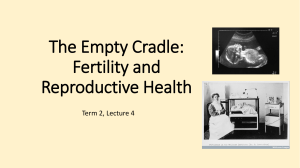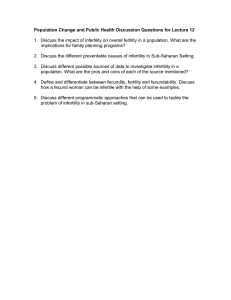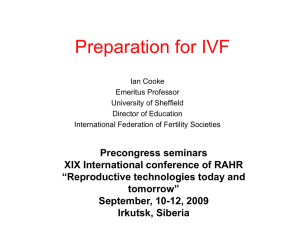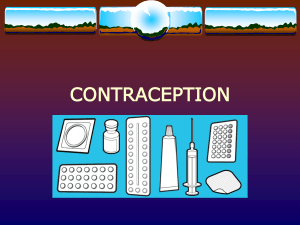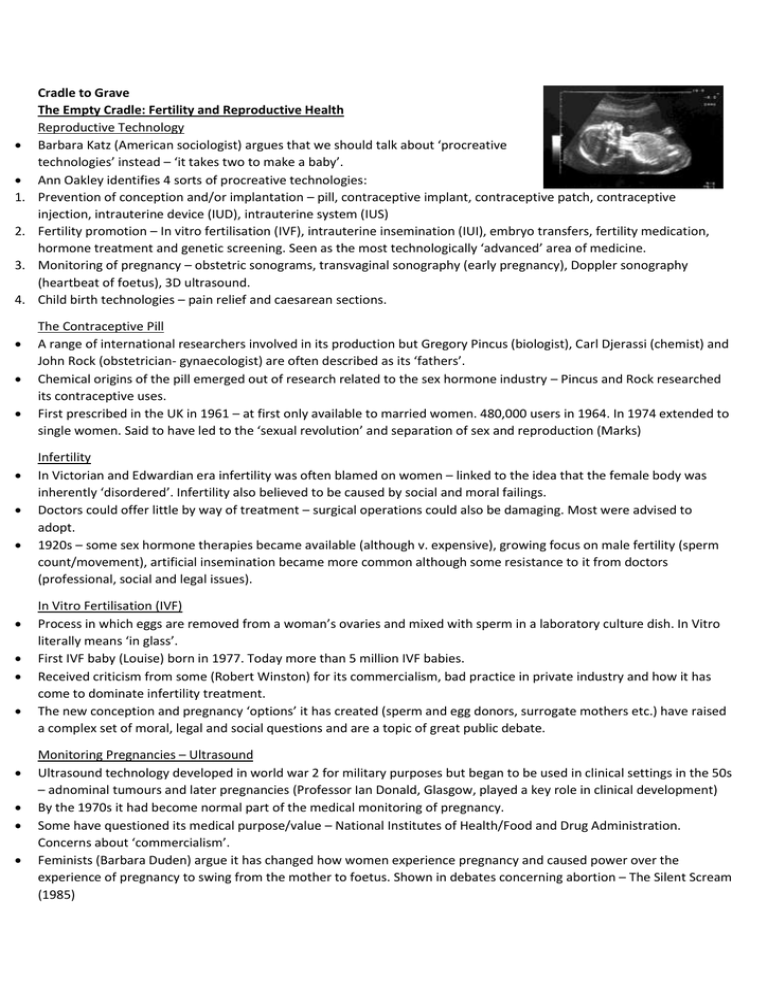
1.
2.
3.
4.
Cradle to Grave
The Empty Cradle: Fertility and Reproductive Health
Reproductive Technology
Barbara Katz (American sociologist) argues that we should talk about ‘procreative
technologies’ instead – ‘it takes two to make a baby’.
Ann Oakley identifies 4 sorts of procreative technologies:
Prevention of conception and/or implantation – pill, contraceptive implant, contraceptive patch, contraceptive
injection, intrauterine device (IUD), intrauterine system (IUS)
Fertility promotion – In vitro fertilisation (IVF), intrauterine insemination (IUI), embryo transfers, fertility medication,
hormone treatment and genetic screening. Seen as the most technologically ‘advanced’ area of medicine.
Monitoring of pregnancy – obstetric sonograms, transvaginal sonography (early pregnancy), Doppler sonography
(heartbeat of foetus), 3D ultrasound.
Child birth technologies – pain relief and caesarean sections.
The Contraceptive Pill
A range of international researchers involved in its production but Gregory Pincus (biologist), Carl Djerassi (chemist) and
John Rock (obstetrician- gynaecologist) are often described as its ‘fathers’.
Chemical origins of the pill emerged out of research related to the sex hormone industry – Pincus and Rock researched
its contraceptive uses.
First prescribed in the UK in 1961 – at first only available to married women. 480,000 users in 1964. In 1974 extended to
single women. Said to have led to the ‘sexual revolution’ and separation of sex and reproduction (Marks)
Infertility
In Victorian and Edwardian era infertility was often blamed on women – linked to the idea that the female body was
inherently ‘disordered’. Infertility also believed to be caused by social and moral failings.
Doctors could offer little by way of treatment – surgical operations could also be damaging. Most were advised to
adopt.
1920s – some sex hormone therapies became available (although v. expensive), growing focus on male fertility (sperm
count/movement), artificial insemination became more common although some resistance to it from doctors
(professional, social and legal issues).
In Vitro Fertilisation (IVF)
Process in which eggs are removed from a woman’s ovaries and mixed with sperm in a laboratory culture dish. In Vitro
literally means ‘in glass’.
First IVF baby (Louise) born in 1977. Today more than 5 million IVF babies.
Received criticism from some (Robert Winston) for its commercialism, bad practice in private industry and how it has
come to dominate infertility treatment.
The new conception and pregnancy ‘options’ it has created (sperm and egg donors, surrogate mothers etc.) have raised
a complex set of moral, legal and social questions and are a topic of great public debate.
Monitoring Pregnancies – Ultrasound
Ultrasound technology developed in world war 2 for military purposes but began to be used in clinical settings in the 50s
– adnominal tumours and later pregnancies (Professor Ian Donald, Glasgow, played a key role in clinical development)
By the 1970s it had become normal part of the medical monitoring of pregnancy.
Some have questioned its medical purpose/value – National Institutes of Health/Food and Drug Administration.
Concerns about ‘commercialism’.
Feminists (Barbara Duden) argue it has changed how women experience pregnancy and caused power over the
experience of pregnancy to swing from the mother to foetus. Shown in debates concerning abortion – The Silent Scream
(1985)



